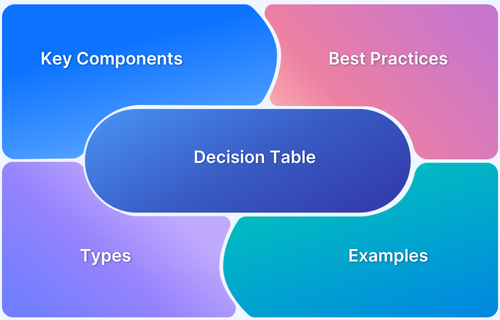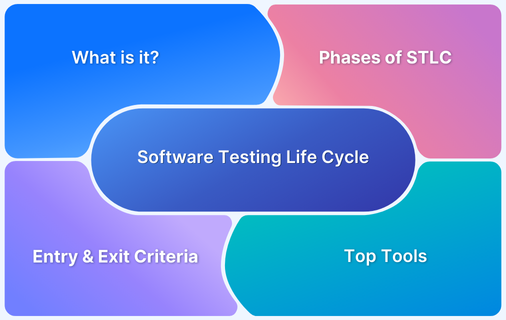In software testing, it’s important to check how a system behaves with different inputs. A Decision Table is a useful tool for organizing and managing these different combinations. It helps testers figure out how different conditions and actions should work together, making sure all possible scenarios are tested.
This article covers how Decision Tables can be used in software testing to create better test cases. They help testers manage complex conditions and ensure that all possible outcomes are checked without missing anything. By using Decision Tables, the testing process becomes more organized, thorough, and efficient.
Overview
What is a Decision Table?
A structured tool in software testing that maps various input conditions to corresponding actions, ensuring comprehensive test coverage.
Key Components of a Decision Table:
- Conditions: Inputs influencing decisions.
- Actions: Expected outcomes based on conditions.
- Condition Alternatives: Possible states of each condition.
- Decision Rules: Logical combinations of conditions determining actions.
- Action Entries: Specific actions for each condition combination.
Types of Decision Tables:
- Limited Decision Table
- Extended Decision Table
- Condition-Action Table
- Switch Table
- Rule-Based Decision Table
What is a Decision Table?
A Decision Table is a tool used in software testing to represent and analyze different combinations of conditions and actions.
It is especially useful when the logic for making decisions in a system is complex, involving multiple conditions that must be tested. By organizing the conditions and corresponding actions in a structured, tabular format, decision tables help testers visualize and verify all possible outcomes based on different input combinations.
In simpler terms, a decision table acts as a decision-making guide, helping to ensure that all combinations of conditions (input data) and actions (expected outputs) are covered during testing. It is a practical technique for both manual and automated testing, as it ensures that all scenarios are considered and tested, reducing the risk of missing any crucial test case.
Key Components of a Decision Table
A typical decision table consists of the following key components:
- Conditions: These are the inputs or variables that influence the decision-making process. Each condition can have different possible states or values (like true/false, yes/no, or different ranges of values). The conditions are typically represented as columns in the table.
- Actions: These are the expected outcomes or responses triggered by specific combinations of conditions. Actions specify the outcomes that occur when specific conditions are satisfied. Each action is typically represented as a column corresponding to the set of conditions.
- Condition Alternatives: For each condition, there can be multiple alternatives or possible values. For instance, if a condition checks whether a user’s age is above a certain threshold, the alternatives could be “Age > 18” or “Age ≤ 18”. These alternatives are listed in rows beneath the condition.
- Decision Rules: Each row in the decision table corresponds to a specific combination of condition values (alternatives). A decision rule specifies what actions are to be taken for each specific combination of conditions. It indicates how the system should behave for each situation.
- Action Entries: These indicate which actions to take for each combination of condition alternatives. Action entries are placed in the decision table according to the decision rules defined by the tester.
- Decision Outcome: The result that comes from evaluating a specific combination of conditions and actions. It helps the tester check if the system behaves as expected for every scenario defined in the table.
Types of Decision Tables
Decision tables can be categorized into several types, each designed to handle different levels of complexity in decision-making logic. Depending on the number of conditions, their interdependencies, and the required actions, different types of decision tables can be used to model the decision logic more effectively.
Below are the key types of decision tables:
1. Limited Decision Table
A Limited Decision Table is used when the conditions are simple and independent, typically with two possible values (for example, True/False). It is the most basic form, offering minimal complexity for straightforward decision-making scenarios.
Example: Login system where conditions are “Username Valid” and “Password Correct.”
2. Extended Decision Table
An Extended Decision Table handles more complex scenarios involving multiple conditions with various alternatives and potential interdependencies. This type is used when the decision logic is intricate and there are many possible combinations of conditions.
Example: Loan approval system with conditions like “Income,” “Credit Score,” and “Debt-to-Income Ratio.”
3. Condition-Action Table
A Condition-Action Table maps conditions directly to actions, making it easier to visualize how each condition triggers a specific outcome. It’s particularly useful for systems where conditions have a clear, direct impact on actions.
Example: Discount system where “Membership” and “Purchase Total” determine the discount.
4. Switch Table
A Switch Table is used when decisions are based on a single condition’s value. This type simplifies decision-making by focusing on one key condition that determines the outcome.
Example: Traffic light control system where the action depends on the light color (Red, Yellow, Green).
5. Rule-Based Decision Table
A Rule-Based Decision Table integrates multiple decision rules to handle complex conditions and actions. It is suitable for systems with several interacting conditions and rules that dictate outcomes.
Example: Insurance eligibility system based on “Age,” “Driving Record,” and “Location.”
The table below summarizes the characteristics and use cases for different types of decision tables.
| Type of Decision Table | Characteristics | Use Case Example |
|---|---|---|
| Limited Decision Table | Simple, conditions are independent, few combinations. | Basic systems with simple conditions. |
| Extended Decision Table | Complex, handles multiple conditions and interdependencies. | Systems with more intricate decision logic. |
| Condition-Action Table | Directly links conditions to actions. | Situations where conditions directly map to actions. |
| Switch Table | Decisions are based on a single condition. | Systems with simple decision trees. |
| Rule-Based Decision Table | Combines multiple rules to define conditions and actions. | Expert systems or rule-based decision-making. |
Read More: Black Box Testing: Types, Tools and Examples
How to Create a Decision Table?
Creating a decision table is a structured process that helps organize the conditions and actions clearly, ensuring that all possible outcomes are considered. Here’s how you can create one:
Step 1. Identify the Conditions: These are the factors that will influence the decision. Think about the inputs that will determine the result. For example, in a login system, conditions might be “Is the username valid?” and “Is the password correct?”
Step 2. Define Possible Condition Alternatives: For each condition, define the possible outcomes or values (for example, Yes/No, True/False, or ranges like “greater than 100” or “less than 100“).
Step 3. Define the Actions: These are the results that follow from the conditions being met. Actions could be something like “Allow login,” “Deny access,” or “Apply discount.”
Step 4. Map Out the Rules: Create rows that represent all combinations of the conditions. Each row shows a rule and the resulting action based on the conditions.
Step 5. Fill in the Table: Based on the combinations of conditions, determine the corresponding action for each rule and fill it into the table.
Step 6. Simplify: If there are redundant or conflicting rules, simplify them to improve clarity and efficiency.
Take a look at the example below:
For a basic login system, the conditions might be:
- Condition 1: Is the username valid? (Yes/No)
- Condition 2: Is the password correct? (Yes/No)
Possible actions could be:
- Action 1: Allow login
- Action 2: Deny login
After considering all combinations of conditions, you would create a decision table to map out the appropriate actions.
Read More: What is Alpha Testing
Examples of Decision Tables in Software Testing
Here are a few examples of decision tables used in software testing:
Example 1: Login System
For a login system that checks if the username and password are correct:
- Condition 1: Is the username valid?
- Condition 2: Is the password correct?
Actions:
- Action 1: Allow login
- Action 2: Deny login
| Condition 1 (Username Valid) | Condition 2 (Password Correct) | Action 1 (Allow Login) | Action 2 (Deny Login) |
|---|---|---|---|
| Yes | Yes | Yes | No |
| Yes | No | No | Yes |
| No | Yes | No | Yes |
| No | No | No | Yes |
Example 2: Discount System
For an online store offering discounts based on membership and total purchase amount:
- Condition 1: Is the customer a member?
- Condition 2: Is the total purchase above $100?
Possible actions:
- Action 1: 10% discount
- Action 2: 5% discount
- Action 3: No discount
| Condition 1 (Is Member) | Condition 2 (Total > $100) | Action 1 (10% Discount) | Action 2 (5% Discount) | Action 3 (No Discount) |
|---|---|---|---|---|
| Yes | Yes | Yes | No | No |
| Yes | No | No | Yes | No |
| No | Yes | No | Yes | No |
| No | No | No | No | Yes |
Use Cases of Decision Tables in Software Testing
Decision tables are widely used in software testing to handle complex decision-making scenarios. They provide a clear and structured way to test all possible combinations of conditions, ensuring comprehensive coverage. Here are some common use cases:
- Validating Business Logic: Decision tables are great for testing systems with complex business rules. For example, in an insurance or loan approval system, decision tables ensure all factors (like age, income, and credit score) are properly evaluated to produce the correct action (approve/deny).
- Generating Test Cases: Decision tables help testers generate test cases that cover all combinations of input conditions. This ensures that no scenario is overlooked, especially edge cases, which might otherwise be missed in simpler test designs.
- Verifying System Behavior: In systems where behavior changes based on different input combinations (for example, payment status and shipping address in an order processing system), decision tables ensure that all possible scenarios are tested, and the system responds as expected.
- Automating Tests: Decision tables are easy to translate into automated test scripts. They provide a structured format that makes it simple to implement tests across different combinations of conditions, ensuring consistency and accuracy in automated testing.
- Ensuring Regulatory Compliance: For systems that need to comply with specific regulations (like healthcare or finance), decision tables help ensure that all compliance rules are properly checked. Each condition (for example, location, age) can be directly mapped to regulatory actions, ensuring the system follows the required guidelines.
Advantages of Decision Tables
Decision tables bring several important benefits to software testing, especially when you need to manage complex logic.
Here’s why they’re so useful:
1. Clear Representation of Logic: One of the biggest advantages of decision tables is that they make complex rules easy to understand. By laying out the conditions and possible actions in a simple, visual format, they help everyone—developers, testers, and stakeholders—see how different inputs lead to specific outputs. This makes it much easier to spot errors in the decision logic.
2. Thorough Test Coverage: Decision tables are great for ensuring that all scenarios are tested. They help you list every possible combination of conditions, which means you can create test cases that cover all possible outcomes. This reduces the chances of missing edge cases or scenarios that might break the system.
Read More: How to Maximize Test Coverage
3. Streamlining Complex Scenarios: When multiple conditions are in play, managing all the combinations manually can get tricky. Decision tables simplify this by organizing all possible input combinations and showing the corresponding actions. This reduces complexity and helps testers easily design comprehensive test cases without overlooking any condition.
4. Automation-Friendly: Since decision tables follow a clear structure, they’re easy to translate into automated tests. With automated testing, you can quickly check whether the system behaves as expected across all conditions. This can save a lot of time, especially for large-scale projects, and ensures consistency in testing.
5. Better Communication Across Teams: Having a decision table is like having a shared map for everyone involved in the project. It clearly outlines how the system is supposed to behave, which helps ensure that developers, testers, and business teams are all aligned. This clears up confusion and makes sure everyone is aligned.
Limitations of Decision Tables
While decision tables are powerful, they do come with their own set of challenges. Here are few things to remember:
- Scalability Issues with Large Numbers of Conditions: The more conditions you have, the bigger and more complicated the decision table becomes. With a large number of conditions, the table can grow quickly, leading to an overwhelming number of combinations to manage. It can also make it harder to keep track of changes over time.
- Not Ideal for Real-Time or Dynamic Decisions: Decision tables are great for static or well-defined rules, but they’re not the best fit for real-time decision-making. If your system needs to make decisions based on constantly changing or unpredictable data, decision tables can struggle to handle that complexity.
- Hard to Handle Interdependent Conditions: Decision tables are most effective when conditions are independent of one another. If the outcome of one condition affects another, the table can become overly complicated or fail to capture all the necessary interactions. You might need to use additional logic or methods to handle these interdependencies.
- Struggles with Continuous Conditions: Decision tables work best with discrete conditions like Yes/No or specific values. When you’re dealing with continuous or range-based data (for example, temperatures or prices within a range), it can be tough to represent those conditions accurately in a decision table, as there are too many possibilities to capture.
- Difficult to Update in Large Systems: In large, evolving systems, decision tables can become a maintenance burden. As business rules change, the table needs to be updated to reflect these changes. This can be time-consuming, especially if the system involves many conditions that shift over time.
Read More: Software Testing Techniques
Challenges of Using Decision Tables in Software Testing and Its Solutions
Despite their advantages, decision tables can present some challenges when used in software testing. However, with the right strategies, these obstacles can be addressed effectively.
Here are some common challenges and how to address them:
- Handling a Large Number of Conditions
- Managing Interdependent Conditions
- Updating and Maintaining Tables for Evolving Systems
- Dealing with Complex or Continuous Data
1. Handling a Large Number of Conditions
As the number of conditions grows, decision tables can become overwhelming and harder to manage. The number of possible combinations increases quickly, making the table difficult to read and maintain.
Solution: Break the decision table into smaller, more manageable sections. Instead of fitting everything into one large table, create several smaller tables that focus on different parts of the system. You can also prioritize the most important combinations and simplify the less critical ones.
2. Managing Interdependent Conditions
When conditions are interdependent, decision tables can become more complex and harder to interpret. Often, some conditions depend on others, which makes it tough to represent them as separate variables.
Solution: In these cases, consider using a decision matrix or adding extra logic outside the decision table. Another option is to separate related conditions into different tables and combine them later in the testing process.
3. Updating and Maintaining Tables for Evolving Systems
As systems and business rules change over time, decision tables need to be updated regularly. This can be a time-consuming task.
Solution: Set up a process to review and update the tables regularly as business requirements evolve. Automation can also reduce the effort required to update test cases. Additionally, using version control for decision tables can help track changes and make updates easier.
4. Dealing with Complex or Continuous Data
Decision tables work well with discrete conditions (like Yes/No or True/False), but they’re not well-suited for continuous data, such as ranges or measurements.
Solution: For continuous data, group values into ranges (for example, low, medium, high) to fit them into the decision table. Alternatively, you can combine decision table testing with other techniques, such as boundary value analysis or equivalence partitioning, to handle continuous data more effectively.
Best Practices for Using Decision Tables in Testing
To get the most out of decision tables in software testing, here are some best practices that can help ensure efficiency and accuracy:
1. Test in a Real User Environment: Testing in a controlled, ideal environment is useful, but it doesn’t always reveal how the system will behave under real-world conditions. For accurate results, always test decision tables in environments that simulate how end-users will interact with the system.
The best solution is to use tools like BrowserStack Automate, which provides a real user environment where you can run automated tests across multiple browsers and devices. This helps ensure that your decision tables accurately represent user interactions and that your system behaves as expected under various real-world conditions.
2. Break Down Complex Tables: As mentioned, large decision tables can become overwhelming. A good practice is to break them into smaller, more focused tables that are easier to manage and test. Each table should represent a specific part of the system’s logic or a specific user scenario, making it more efficient to create and update.
3. Keep Conditions Independent When Possible: For decision tables to be effective, try to keep the conditions as independent as possible. Interdependent conditions can add unnecessary complexity. If the conditions must be interdependent, consider separating them into different tables or using other techniques like decision trees or state transition diagrams for better clarity.
4. Leverage Equivalence Partitioning: When dealing with conditions involving value ranges (for example, age 20-80), group values into equivalence partitions to minimize redundant test cases. Focus on testing representative values and include tests at the boundaries to ensure comprehensive coverage.
5. Validate Boundary Conditions: Test inputs at the edges of acceptable ranges to verify the system’s behavior under boundary scenarios. This helps uncover potential edge-case issues and ensures robust system performance.
6. Review and Simplify Regularly: Regularly review your decision tables to ensure they are still valid and reflective of the business logic. As business rules evolve, it’s important to simplify and refactor the tables to keep them manageable and efficient.
7. Automate Tests Using Decision Tables: Once you’ve created your decision tables, automate them whenever possible. This will ensure that the tests run consistently and can be easily repeated. Automation tools like Selenium or tools integrated with platforms like BrowserStack allow you to execute these tables across multiple environments, improving both the scope and efficiency of your tests.
8. Collaborate with Stakeholders: Make sure to collaborate with business analysts, product owners, and developers when creating decision tables. Their insights into how the system should behave in different scenarios can help refine the tables and ensure that you’re testing the right conditions.
Conclusion
Decision tables are a great tool for organizing complex decision logic and ensuring that your tests are comprehensive. They help simplify testing by clearly showing how different inputs affect the system’s behavior.
However, for systems with many conditions or dynamic, real-time decisions they can become unwieldy. While they’re a strong choice for many scenarios, it’s essential to know when to use them and when to look for alternatives.
Leverage testing tools like BrowserStack Automate for decision table testing to evaluate conditions in real user environments including latest devices, multiple browsers versions and operating systems.





